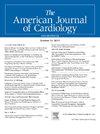Health Care Resource Utilization Following Acute Myocardial Infarction: Findings from the RECORD-MI Registry
IF 2.3
3区 医学
Q2 CARDIAC & CARDIOVASCULAR SYSTEMS
引用次数: 0
Abstract
The contemporary health care resource utilization after an acute myocardial infarction (MI) is not well-known. All patients admitted because of MI between January 2015 and December 2021 across 28 hospitals in the Baylor Scott & White Health system were studied. Patient characteristics and outcomes, including all-cause and cardiovascular (CV) rehospitalizations, emergency department (ED) visits, and outpatient visits were evaluated. Of 6,804 patients admitted because of MI, 6,556 were discharged alive. The median age was 69 years, 60% were men, and 77% had non–ST-elevation MI; 17% (1,090) had multivessel disease. The number of patients with first all-cause readmissions within 30 days, 3 months, and 12 months of discharge were 844 (13%), 1,372 (21%), and 2,306 (35%), respectively, with a higher readmission rate in patients with non–ST-elevation MI, previous heart failure (HF), new-onset HF, and left ventricular ejection fraction ≤40%. ED visits at 12 months for any cause were 2,401 (37%), of which 1,321 (55%) were for any CV cause, with a higher incidence in patients with previous HF. Of the 6,556 patients, 4,102 (63%) had at least 1 primary care visit in the past year, 5,009 (76%) had CV specialty visits, and 3,860 (59%) had non-CV visits, with a similar distribution across subgroups. Patients hospitalized with an MI had a high risk of subsequent hospital readmissions and ED and outpatient visits, especially those with a previous HF diagnosis and those discharged with an MI and HF diagnosis.
来自 RECORD-MI 登记处的急性心肌梗死后医疗资源利用情况:心肌梗死后的医疗资源利用。
背景:急性心肌梗死(MI)后的当代医疗资源利用情况尚不十分清楚:方法:研究了贝勒斯科特与怀特医疗系统 28 家医院 2015 年 1 月至 2021 年 12 月期间因心肌梗死入院的所有患者。对患者的特征和预后进行了评估,包括全因和心血管(CV)再住院、急诊科就诊和门诊就诊:在因心肌梗死入院的 6804 名患者中,有 6556 人活着出院。中位年龄为69岁,60%为男性,77%为非ST段抬高型心肌梗死(NSTEMI);17%(1090人)患有多血管疾病。出院后30天、3个月和12个月内首次全因再入院的患者人数分别为844人(13%)、1372人(21%)和2306人(35%),其中NSTEMI、既往心衰(HF)、新发HF和左室射血分数(LVEF)≤40%的患者再入院率较高。12个月内,因任何原因到急诊就诊的患者有2401人(37%),其中1321人(55%)是因任何CV原因就诊,既往患有HF的患者发病率较高。在6556名患者中,有4102人(63%)在过去一年中至少接受过一次初级保健就诊,5009人(76%)接受过冠心病专科就诊,3860人(59%)接受过非冠心病就诊,各亚组的分布情况相似:心肌梗死住院患者后续再入院、急诊室就诊和门诊就诊的风险很高,尤其是在既往有心房颤动诊断以及出院时既有心肌梗死诊断又有心房颤动诊断的患者中。
本文章由计算机程序翻译,如有差异,请以英文原文为准。
求助全文
约1分钟内获得全文
求助全文
来源期刊

American Journal of Cardiology
医学-心血管系统
CiteScore
4.00
自引率
3.60%
发文量
698
审稿时长
33 days
期刊介绍:
Published 24 times a year, The American Journal of Cardiology® is an independent journal designed for cardiovascular disease specialists and internists with a subspecialty in cardiology throughout the world. AJC is an independent, scientific, peer-reviewed journal of original articles that focus on the practical, clinical approach to the diagnosis and treatment of cardiovascular disease. AJC has one of the fastest acceptance to publication times in Cardiology. Features report on systemic hypertension, methodology, drugs, pacing, arrhythmia, preventive cardiology, congestive heart failure, valvular heart disease, congenital heart disease, and cardiomyopathy. Also included are editorials, readers'' comments, and symposia.
 求助内容:
求助内容: 应助结果提醒方式:
应助结果提醒方式:


